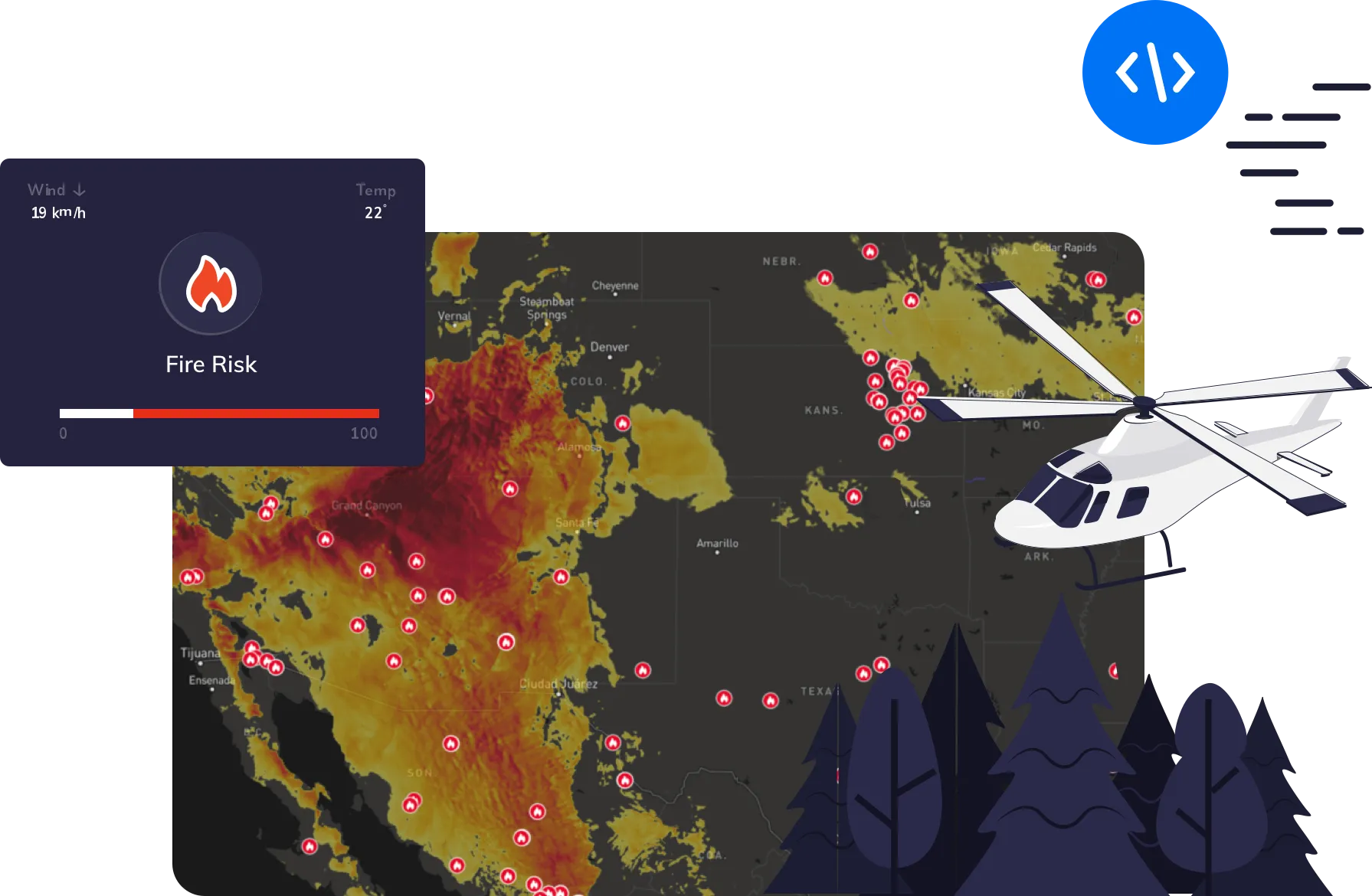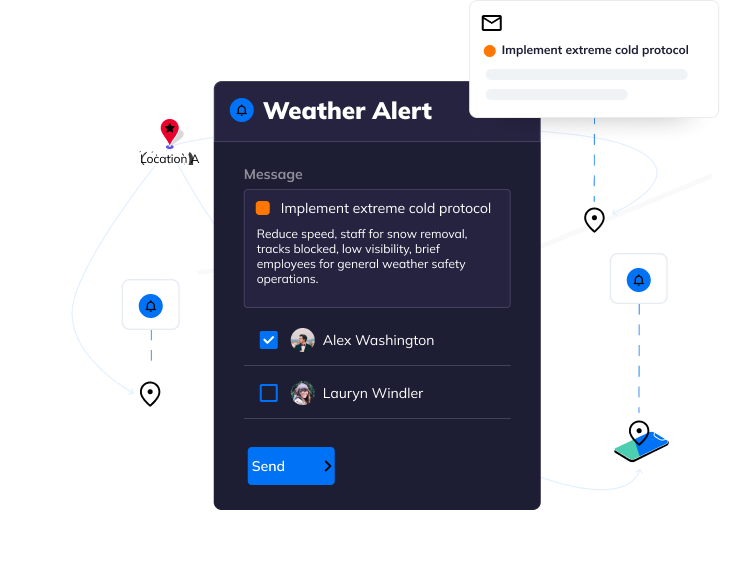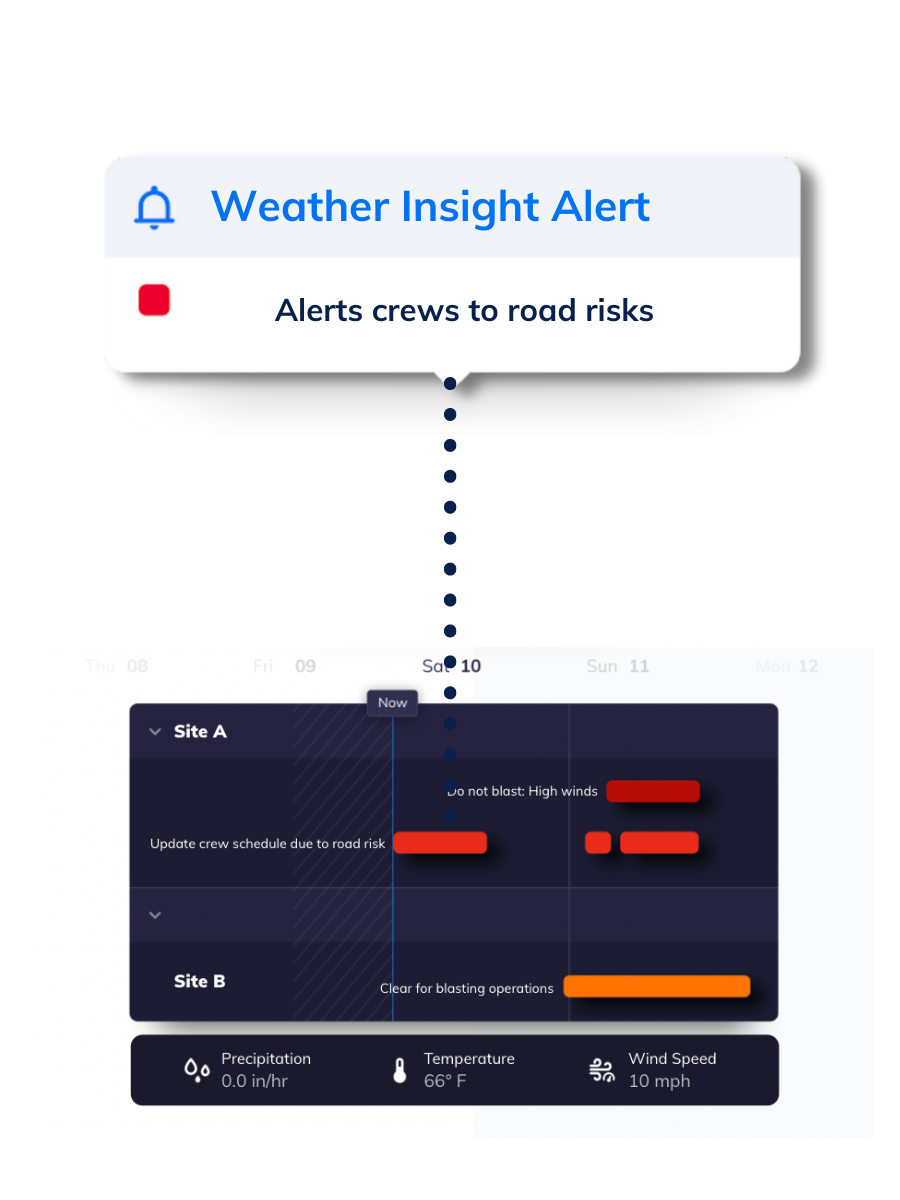Stay a Step Ahead With Proactive Weather Alerts and Notifications


Optimize Operations Before Weather Happens
Weather has a significant impact on the way we work, live, and run our businesses. And without advanced warning, its impact can be destructive. Nearly 40% of businesses, for example, shut their doors permanently after being impacted by a natural disaster, and many
That’s why advanced weather alerts are such a critical tool. Tomorrow.io’s Weather API offers alerts and notifications that not only save lives, but also empower businesses, governments, and countries to avoid and prepare for weather-related losses. With weather alerts and notifications, your team can reduce the risks around interrupted workflows, productivity, revenue streams, and business continuity.
The Risks of Not Using Weather Alerts and Notifications
Direct business losses aren’t the only business risks: many weather-related interruptions are indirect impacts, including changes in customer and staff behaviors. Severe weather events like hurricanes, cyclones, floods, and blizzards, not only threaten livelihoods but interfere with the general status quo in communities. Any business that sells to these communities or has staff in the area will experience a drop in production capacity and demand. Without leveraging weather alerts and notifications, these businesses won’t be able to support consumer interests, protect staff, and manage assets.
Unpredicted weather events also pose serious consequences and missed opportunities to optimize sales for the retail industry. Without weather alerts and notifications, these businesses aren’t able to predict weather conditions and forecast demand dips and spikes. Not knowing that a blizzard is on the way, for example, could leave an apparel retailer unable to stock cold-weather items in time for the peak in demand. Besides using weather alerts and notifications to analyze sales, they also allow organizations to keep customers safe and avoid hefty fines from damage.
Energy and utility organizations who don’t use weather alerts and notifications also face a number of threats. It’s not uncommon for thousands of residential homes to lose power in the wake of extreme weather, creating a dire situation for power companies. Without weather alerts and notifications, these utility and energy companies aren’t able to protect their assets, reduce the risk of equipment damage, or help their customers personally prepare for outages. With the advanced warning of weather alerts, though, energy and utility customers are able to be proactive, taking the necessary steps to find backup power sources or evacuate in life-threatening situations.


Configuring Weather Alerts and Notifications for Advanced Action
With the Tomorrow.io Weather API, businesses can create advanced weather alerts and notifications to work with any internal application in order to optimize sales, help consumers, protect assets, and more. The Tomorrow.io Weather API contains endpoints that organize data in a way that makes it convenient for developers to create a simple POST or GET call and get minute-by-minute, hour-by-hour, or a customized timeframe to predict future events.
Developers start with the Insights endpoint. This endpoint contains updated data that tracks specific events (e.g., heavy rain or wind). Insights can be customized and built to return specific events and data, or developers can use the many templates available that fit a specific industry. For more advanced queries, developers can create their own custom insight.
Insights offer a quick way to get access to severe weather events, but developers determine when alerts are sent based on the insight data. For example, alerts could be sent only during emergency situations or when official sources send public warnings.
Alerts are sent when a specific condition is met or when future predictions indicate that a severe event is about to affect a given area. Using alerts combined with insights, developers write very little code to determine when a specific geographic area could be affected by severe weather conditions and communicate with subscribers.
Notifications are the final step to send messages to all alert subscribers. Developers can choose to send notifications before an event happens, at the start of an event, after the event, or as soon as weather condition alerts are published by authorities. Using granular notification options lets developers use notifications for warnings or information in the aftermath of an event.
Webhooks are a good way to automatically include notifications and alerts in your applications. You could continually poll the API for notifications, but this takes excessive resources. Instead, Tomorrow.io’s Weather API offers webhooks. Webhooks push notifications to your application so that your code doesn’t need to poll the API. It’s important to pick the right locations to display notifications in your application, or you could display alerts to the wrong users.
Developers can use a variety of ways to pull notifications from Tomorrow.io’s Weather API and display the parsed JSON in their applications. As an example, a JavaScript Express web server can be created to listen for notifications.
const express = require('express');
const bodyParser = require('body-parser');
const app = express();
app.use(bodyParser.urlencoded({ extended: false }));
app.use(bodyParser.json());
app.post('/notifications', (req, res) => {
// handle webhook payload (res.body.data)
// your code goes here
res.sendStatus(200);
});
let server = app.listen(3000, function() {
console.log('Listening on port %d', server.address().port);
});
import requests
url = "https://api.tomorrow.io/v4/alerts?apikey=YOUR_KEY"
payload = {
"isActive": True,
"insight": "fires",
"name": "Fire Alert",
"notifications": "PRIOR"
}
headers = {
"Accept": "application/json",
"Content-Type": "application/json"
}
response = requests.request("POST", url, json=payload, headers=headers)
print(response.text)
In this Python sample code, a customer alert is created based on the “fires” insight. Notifications are sent when a severe weather event message is sent by an official source based on the “notifications” parameter. In this example, a notification is sent for this alert when a message is published prior to an event.
Weather API Capabilities
Learn more about the Tomorrow.io Weather API’s enterprise-grade capabilities:
Leverage Our Weather Alerts and Notifications for a Variety of Use Cases
The Tomorrow.io Weather API’s weather alerts and notifications offer individuals, businesses, and governments across all industries the ability to generate advanced notice of incoming weather events.
In 2020, Uber shared the many ways the Tomorrow.io Weather API’s weather alerts and notifications improved accuracy of their customers’ estimated time for arrival (ETA) and prepared for certain weather conditions that would require an increase in driver availability (e.g., rain or snow).
Warehousing is one such industry that you might not realize can use a Weather API for hazard prevention. Using weather alerts and notifications from the Tomorrow.io Weather API, warehouses better optimize shift management during hazardous weather, eliminate heat exhaustion for workers during extremely hot days, and manage the supply chain and loss prevention.
Digital marketers who realize the benefits of weather alerts and notifications use the Tomorrow.io Weather API to increase revenue during rapid consumer behavior changes after weather events. Similarly, restaurants, retail stores, and entertainment organizations leverage weather data to promote time-sensitive services and products based on current weather conditions.
Automotive companies can use weather alerts and notifications to improve traffic and road safety amidt weather changes. Not only does weather data help shipping and logistics companies optimize routes for delivery, but it also helps electric car consumers determine travel distance possible on their charged battery, empowers autonomous vehicles to find the safest roads, and more.